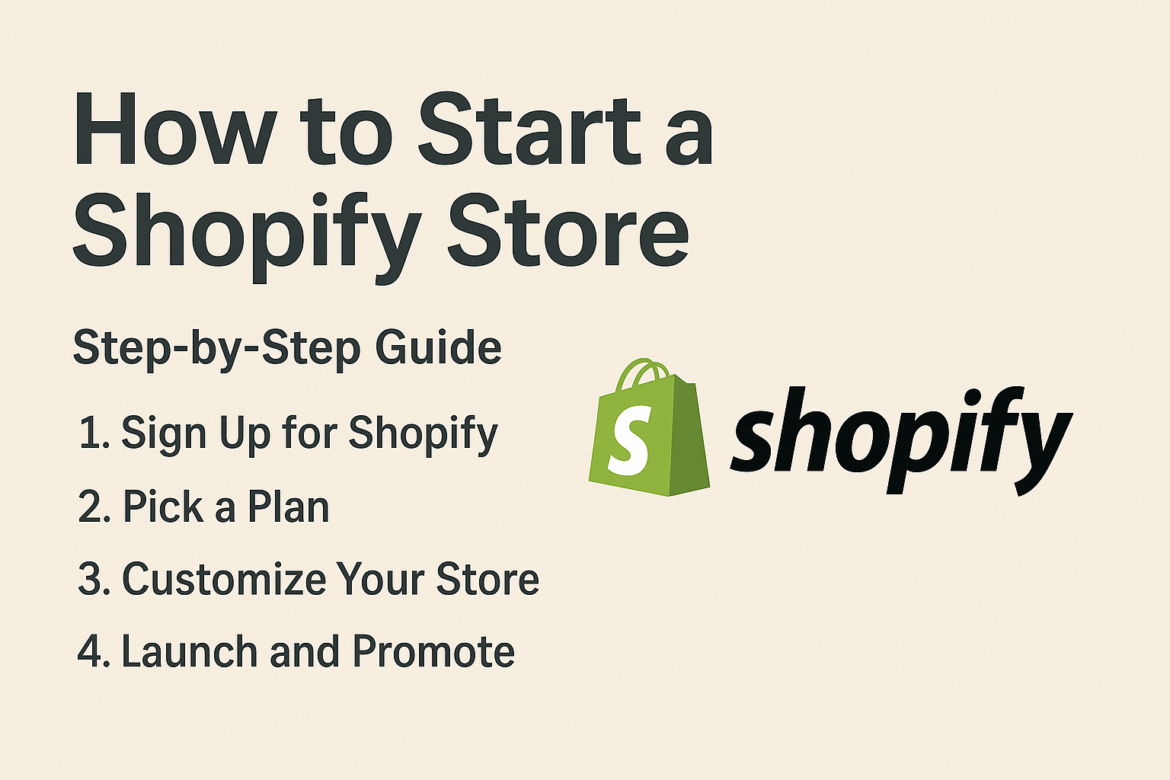
E-commerce is booming, and Shopify is one of the best platforms to start your online store. Whether you’re an aspiring entrepreneur or a small business owner looking to expand online, Shopify provides a user-friendly solution for building and managing an online store. In this detailed guide, we will walk you through every step of starting a Shopify store, from setup to marketing and scaling.
1. Understanding Shopify and Its Benefits
Before diving into the setup process, let’s explore why Shopify is a popular choice for e-commerce:
Why Choose Shopify?
- Ease of Use – No coding or technical skills required.
- Customization – Thousands of themes and apps for customization.
- Payment Processing – Accepts multiple payment methods.
- Scalability – Suitable for businesses of all sizes.
- Customer Support – 24/7 support via chat, email, and phone.
Who Can Benefit from Shopify?
- Individuals looking to start a side business.
- Brick-and-mortar stores expanding online.
- Dropshipping and print-on-demand sellers.
- Large businesses scaling their e-commerce operations.
2. Setting Up Your Shopify Store
Step 1: Sign Up for Shopify
- Go to Shopify’s website.
- Click on “Start Free Trial” and enter your email.
- Follow the prompts to create an account by adding your store name, password, and business details.
- Click “Create your store” to proceed.
Step 2: Choose a Shopify Plan
Shopify offers different pricing plans:
- Basic Shopify – Best for new businesses.
- Shopify – Suitable for growing businesses.
- Advanced Shopify – Ideal for scaling businesses.
- Shopify Plus – Enterprise-level.
Start with the free trial, then choose a plan based on your needs.
Step 3: Customize Your Store
Once inside your Shopify dashboard:
- Select a Theme – Shopify offers free and premium themes in the Shopify Theme Store.
- Customize Your Theme – Use Shopify’s drag-and-drop editor to modify colors, fonts, and layouts.
- Add Your Logo – Upload a professionally designed logo. Use Canva or Shopify’s Hatchful tool if needed.
- Set Up Navigation – Organize menus, categories, and pages for easy browsing.
Step 4: Add Products
To add products:
- Go to Products > Add product in the Shopify dashboard.
- Enter product details:
- Title
- Description
- Price
- Product images
- Inventory quantity
- Variants (size, color, etc.)
- Click “Save” to add the product to your store.
Step 5: Set Up Payments
Shopify supports multiple payment methods:
- Shopify Payments – No extra transaction fees, supports major credit cards.
- PayPal – Great for global transactions.
- Third-party gateways – Stripe, Authorize.net, and others.
- Buy Now, Pay Later – Options like Afterpay, Klarna, or Sezzle.
To enable payments:
- Go to Settings > Payments.
- Choose a payment provider and connect your account.
Step 6: Set Up Shipping
Configure shipping settings under Settings > Shipping and Delivery:
- Flat-rate shipping – Ideal for simple pricing.
- Weight-based shipping – Costs depend on package weight.
- Carrier-calculated rates – Real-time rates from USPS, FedEx, or UPS.
- Free shipping – Boosts conversion rates.
Step 7: Set Up Your Domain
A professional domain name increases trust.
- Go to Settings > Domains.
- Choose Buy new domain or Connect existing domain.
- Purchase a domain directly from Shopify or connect one from providers like GoDaddy or Namecheap.
Step 8: Launch Your Store
Before launching:
- Test your website’s functionality.
- Check product descriptions, pricing, and checkout.
- Set up a Coming Soon page for pre-launch hype.
Once ready, remove the password under Settings > Preferences and click Launch Store!

.
3. Marketing Your Shopify Store
Step 9: Optimize for SEO
Search engine optimization (SEO) improves your store’s ranking on Google. Key steps:
- Use keywords – Optimize product titles, descriptions, and URLs.
- Write unique meta descriptions – Include keywords and a call to action.
- Optimize images – Use compressed images and alt text.
- Create a blog – Share industry tips, product guides, and updates.
Step 10: Social Media Marketing
Social media helps drive traffic and sales.
- Instagram & Facebook – Run targeted ads and influencer collaborations.
- TikTok – Use viral content to boost engagement.
- Pinterest – Pin product images for long-term exposure.
- Twitter/X – Engage with industry trends.
Step 11: Email Marketing
Build customer relationships using email campaigns:
- Use Shopify Email or tools like Klaviyo.
- Send welcome emails to new subscribers.
- Create abandoned cart recovery emails.
- Offer exclusive discounts to loyal customers.
Step 12: Paid Advertising
Boost traffic with:
- Google Ads – Appear in search results for product-related queries.
- Facebook Ads – Target specific audiences based on interests and demographics.
- TikTok Ads – Engage younger audiences with short-form content.
4. Managing and Scaling Your Shopify Store
Step 13: Manage Orders and Customer Service
Efficient order management ensures customer satisfaction.
- Track orders in Orders > All Orders.
- Use apps like Order Printer for invoices.
- Provide live chat with tools like Tidio or Gorgias.
Step 14: Expand with Apps and Integrations
Shopify’s App Store offers tools to enhance functionality:
- Dropshipping – Oberlo, Spocket
- Email marketing – Klaviyo, Mailchimp
- SEO tools – SEO Manager, Plug in SEO
- Customer reviews – Judge.me, Loox
Step 15: Scale with Multichannel Selling
Expand beyond Shopify by selling on:
- Amazon & eBay – Integrate using Shopify apps.
- Facebook & Instagram Shops – Sync products with Meta.
- Etsy – Great for handmade or vintage items.
Step 16: Analyze and Optimize Performance
Track performance in Analytics > Reports:
- Monitor sales trends and traffic sources.
- Improve conversion rates with A/B testing.
- Adjust marketing strategies based on insights.
Final Thoughts
Starting a Shopify store requires planning, setup, marketing, and continuous optimization. With the right strategy, your online store can grow into a profitable business. Whether you’re selling physical products, digital goods, or running a dropshipping business, Shopify provides the tools to succeed.
Now that you know how to start, take action, launch your store, and watch your business thrive!
Find out more about Shopify by clicking this link.
If you found this useful please share it with friends and family, and why not check out our review of Namecheap which is one of the best domain registrars out there.
.
